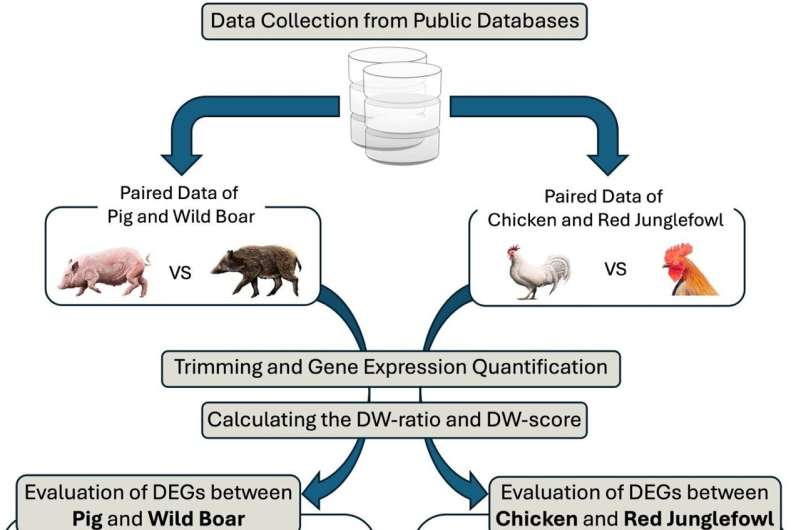This article has been reviewed according to Science X's editorial process and policies. Editors have highlighted the following attributes while ensuring the content's credibility:
fact-checked
peer-reviewed publication
trusted source
proofread
Genetic signatures of domestication identified in pigs and chickens

Wild boars and red junglefowl gave rise to common pigs and chickens. These animals' genes evolved to express themselves differently, leading to signatures of domestication—such as weaker bones and better viral resistance—in pigs and chickens, according to a research team based in Japan.
The findings, published on July 6 in Animals, could provide insight into the genetic changes of the domestication process and highlight target genes for healthier and more productive livestock breeding, the researchers said.
"Through domestication, these animals have been brought under human control and have been selectively bred for specific traits useful to humans, such as faster growth rates, improved meat quality and increased litter size," said corresponding author Hidemasa Bono, professor at Hiroshima University (HU).
Bono is associated with the Laboratory of Genome Informatics in the HU Graduate School of Integrated Sciences for Life and the Laboratory of Bio-DX in the Genome Editing Innovation Center.
"This process has significantly altered the animals' behavior, morphology and physiological functions. … While the selection for traits beneficial to humans has occurred, excessive selective breeding has led to health issues in domesticated animals and decreased their reproductive capacity. To address these issues, it is crucial to understand the changes in gene expression between domesticated animals and their wild ancestors."
By comparing how genes are expressed in pairs of pigs and wild boars, as well as pairs of chickens and red junglefowl, the researchers said they aimed to elucidate common patterns of such changes.
Using data from publicly available databases, they compared 240 genes in pigs and 206 in chickens and found 10 were up-regulated—meaning they were expressed more compared to their wild ancestor partners. They also found seven genes were up-regulated in wild boars and red junglefowl, which have a total of 206 genes and 200 genes, respectively.
"Notably, domesticated animals exhibited higher expression of genes related to viral resistance and bone weakness, whereas their wild ancestors showed higher expression of genes associated with stress response and energy metabolism," said first author Motoki Uno, a graduate student in the Laboratory of Genome Informatics at HU's Graduate School of Integrated Sciences for Life.
"Our analysis revealed that genes commonly up-regulated in pigs and chickens are involved in the immune response, olfactory learning, epigenetic regulation, cell division and the extracellular matrix, which is the molecular structure that gives support to cells and tissues in an organism. In contrast, genes up-regulated in wild boar and red junglefowl are related to stress response, cell proliferation, cardiovascular function, neural regulation and energy metabolism."
According to the researchers, these changes may have come about because domesticated animals are typically kept at high densities in confined spaces, such as chickens in a coop. This closeness can foster more vulnerability to infection as viruses spread, compared to their wild ancestor counterparts.
In contrast, wild boars and red junglefowl are exposed to more stressors in nature, such as avoiding predators and finding food, which could account for the up-regulated genes related to cardiovascular function, neural regulation and energy metabolism.
"These findings provide valuable insights into the genetic basis of the domestication process and highlight potential candidate genes for breeding applications," Bono said.
"Moving forward, we aim to contribute to sustainable breeding through the improvement of analytical methods and the integration of various biological data."
More information: Motoki Uno et al, Transcriptional Signatures of Domestication Revealed through Meta-Analysis of Pig, Chicken, Wild Boar, and Red Junglefowl Gene Expression Data, Animals (2024). DOI: 10.3390/ani14131998
Journal information: Animals
Provided by Hiroshima University



















